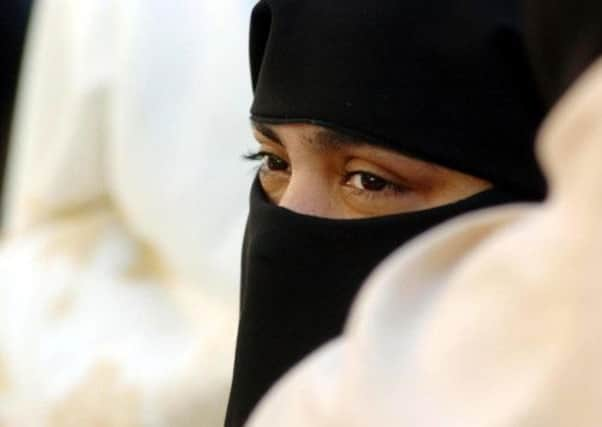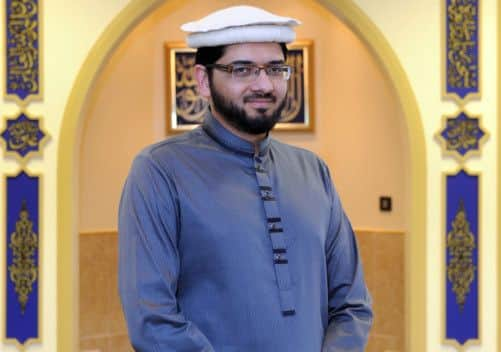Uncovering the faces behind the veil


A GROUP of six women, dressed head to toe in black burqas and carrying designer handbags, enter an upmarket department store just before closing time.
Suddenly, they produce axes and smash their way into display cabinets, stuffing dozens of high value luxury watches worth tens of thousands of pounds into their bags. The group – actually men in disguise – then flee the scene on a trio of waiting getaway motorcycles.
Advertisement
Hide AdAdvertisement
Hide AdIt’s a scenario that plays deeply on our fears about the potential use of the Muslim niqab or face covering not as an instrument of modesty, but as a veil for more sinister motives.


But it’s also a scenario that is absolutely true – it happened at Selfridges in London just weeks ago.
So do incidents like this, rare as they are, mean we should ban the burqa completely?
Is it genuine security fears that fuel our distrust of the niqab – which covers the whole face apart from the eyes – or something deeper? And why are we really so afraid of a woman who chooses to cover her modesty by whatever means, when we can openly endorse seemingly polar opposites such as the Page Three culture?
Advertisement
Hide AdAdvertisement
Hide AdNewspaper articles in recent weeks have described the veil – which is worn by a very small minority of women in the UK – as “pernicious”, “evil”, “anti-feminist”, and symbolic of a backward, patriarchal culture. This has fuelled calls for the niqab to be banned in the UK, as it already has been in France.
But devoted veil-wearers like Miriam, a mother of five from Dewsbury, believe the niqab is the exact opposite of what it is painted as.
Miriam is not an immigrant from the sub-continent or North Africa or the Middle East, but a white Yorkshirewoman of Irish descent who converted to Islam 16 years ago and took the veil before she got married.
“No man decided for me that I would put the niqab on,” the 40-something says. “I wear it because it gives me a sense of freedom. I feel it brings me closer to my creator.
Advertisement
Hide AdAdvertisement
Hide Ad“I integrate, I mix with everyone, I am involved in charities, I do lots of good work. I interact with my neighbours, and no one seems to have a problem. The only people that are oppressing me now are those telling me to remove the veil.
“I choose this myself. But I am oppressed by people telling me in this liberal country that you can’t wear what you want to wear.
“They need to concentrate on the real issues. On crime, on teaching people how to speak English, on all the crimes that are going on in society which are not done by women in niqabs.”
The niqab debate has recently hit the headlines again after a judge refused to let a Muslim woman in a full-length burqa enter a court plea until she revealed her face. The 21-year-old, charged with intimidating a witness, said she could not remove the veil in front of men.
Advertisement
Hide AdAdvertisement
Hide AdThe judge eventually ordered her to take off her full-face veil to give evidence, but let her keep it on for all other parts of her trial.
The case comes seven years after Dewsbury teacher Aishah Azmi sued her local authority when she was sacked because she wanted to wear the veil in the classroom when in the presence of male colleagues. A tribunal dismissed her case for religious discrimination.
However for Miriam, and other niqab wearers, common sense, and the law of the land, prevail, and they disagree with the approaches of women like Ms Azmi, and those using something sacred to mask potential wrongdoing.
“If I was teaching children I would remove it,” Miriam says.
Advertisement
Hide AdAdvertisement
Hide Ad“Muslim women are always identifying themselves where they need to. I am happy to be security checked at an airport by another woman.
“But if someone wants to commit a crime, they will commit it. Don’t use the niqab as an excuse.”
She adds that in the modern world, “interaction” has taken on a whole new meaning anyway.
“I have friends all over the world who have never seen me, but I interact on Facebook with them and we have become the best of friends,” she said. “It would be counterproductive to ban the niqab. It would cause any women who genuinely are pressured to sit indoors, never going out, never interacting with their neighbours. The veil does not stop them doing that.”
Advertisement
Hide AdAdvertisement
Hide AdAnother niqab devotee, Shamila Kauser, 24, has been covering up since she was a teenager.
“Nobody ever pressured me into it. I like it,” she says. “I have got so used to it that if I don’t wear it, I feel naked. I feel protected wearing it. It upsets me that because of a few people, those of us who are just going about our business are also being picked on and demonised. If they ban it, I won’t like it. But if they do, I will follow the law.”
The veil debate is not confined to non-Muslim circles alone.
Qari Asim Mohammed, Imam at Leeds’s Makkah Masjid, stresses that the veil is not a compulsory part of the Islamic dress code, although he supports a woman’s right to choose to wear it. But he says there is a “tiny minority” that considers the veil to be compulsory or recommended – and he believes that for many wearers, it will carry a tinge of political rather than religious symbolism.
Advertisement
Hide AdAdvertisement
Hide Ad“We are not encouraging people to cover their faces and wear niqabs, because our Islam does not say that it’s compulsory,” he says. “Whether it increases modesty or not is very subjective.
“I think it’s partly become more an identity issue than a religious one. There are some other groups as who will politicise it and use it for their own motives.
“But those who do wear it are not oppressed. Even if they wear it, they should not have an issue from a security perspective of identifying themselves. For example when working in primary schools, you will come across male teachers but mostly children. Where do you draw the line?”
He does believe that an all-out ban would be wrong. “Living in this country it could be a huge infringement of freedom of choice, it would set us back, and we pride ourselves on a tolerant, multicultural society,” he says.
Advertisement
Hide AdAdvertisement
Hide Ad“As Muslims we need to strike a balance as well. For those who like to wear it, fine, but when it’s practical, take it off. You have to take an approach at times of will it benefit Islam or not?
He says it is understandable for some people to have a “natural inhibition when you see someone with everything covered”. But he also believes the veil debate itself is getting “inflated and disproportionate coverage” considering the very small number of women who wear the niqab.
Niqab is the piece of cloth which covers the face. It is worn by many Muslim women across Saudi Arabia, and is popular in parts of the Indian subcontinent.
Scholarly opinion varies, but most Islamic experts agree that it is not religiously obligatory.
Advertisement
Hide AdAdvertisement
Hide AdThe veil actually pre-dates Islam, and was practiced in many cultures before the religion’s arrival 1,400 years ago. In fact, commentators have noted that it is referred to in the Bible more explicitly than in the Quran.
Qari Asim Mohammed says the wearing of the veil can be linked to culture as well as religion. He says it was a common practice in parts of India like the Gujarat region, for example, and there are many wearers in Batley and Dewsbury from that community.
He points out, too, that a lot of the history of the veil refers back to aristocrats in both Europe and the Middle East, and how their ladies historically dressed in relation to their place in society.
It’s clearly an issue that provokes debate and divides opinion and it doesn’t look as though that’s about to change any time soon.